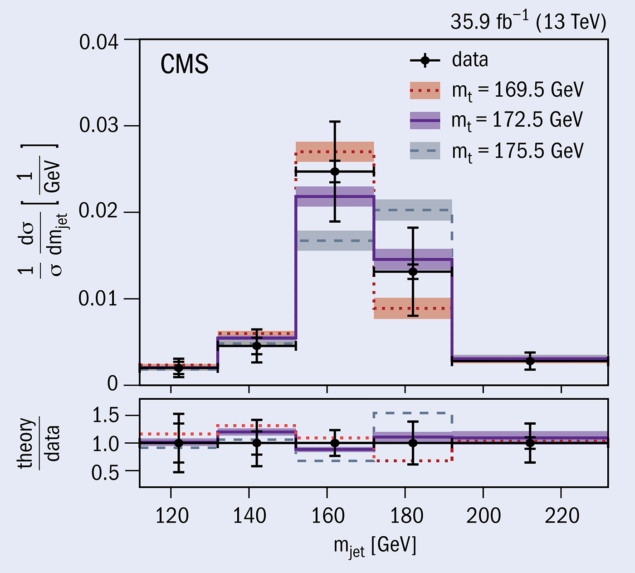A report from the CMS experiment

Weighing in at 180 times the mass of the proton, the top quark is the heaviest elementary particle discovered so far. Because of its large mass, it is the only quark that does not form bound states with other quarks but decays immediately after it has been produced. Despite its short lifetime, its existence has far-reaching consequences. It governs the stability of the electroweak vacuum, gives large contributions to the mass of the W boson, and influences many other important observables through quantum-loop corrections. An accurate knowledge of its mass is important for our understanding of fundamental interactions.
The top quark governs the stability of the electroweak vacuum
The LHC’s high centre-of-mass energy makes it an ideal laboratory to study the properties of the top quark with unprecedented precision. Such studies demand that jets originating from light and bottom quarks are measured very accurately, however, subtleties remain even then, as exact calculations are not possible for low-energy quarks and gluons once they start to form bound states. In this regime, our approximations become inaccurate, because the mass of the bound states becomes as large as the energy of the underlying process. An exciting way to overcome these difficulties is to measure top quarks that have been produced with very high transverse momenta and thus large Lorentz boosts. In these topologies, the decay products are highly collimated, and can be clearly assigned to a decaying top quark. Effects from the formation of hadrons play a minor effect in boosted topologies as the top quarks, which were originally produced in quark–antiquark pairs, move apart from each other fast enough that their decays can be considered to happen independently.
Boosted precision
By reconstructing a boosted top quark in a single jet, a measurement of the jet mass can be translated into one of the top-quark mass. The CMS collaboration has carried out such a measurement using the √s = 13 TeV data collected in 2016, reconstructing the top-quark jets with the novel XCone algorithm to obtain a top quark mass of 172.6 ± 2.5 GeV (figure 1). Due to this new way of reconstructing jets, an improvement of more than a factor of three relative to an earlier measurement at √s = 8 TeV has been achieved. Although the uncertainty is larger than for direct measurements, where top quarks are reconstructed from multiple jets or leptons and missing transverse momentum (which currently yield a world average of 172.9 ± 0.4 GeV from a combination of CMS, ATLAS and Tevatron measurements), this new result shows for the first time the potential of using boosted top quarks for precision measurements.
The jet mass can be translated into the top-quark mass
Measuring the properties of the top quark at high momenta enables detailed studies of a theoretically compelling kinematic regime that has not been accessible before. Different effects, such as the collinear radiation of gluons and quarks, govern its dynamics compared to top-quark production at low energies. Exploiting the full Run-2 dataset should allow CMS to extend this measurement to higher boosts, and establish the boosted regime for a number of precision measurements in the top-quark sector in Run 3 and at the high-luminosity LHC.
Further reading
CMS Collab. 2019 arXiv:1911.03800.








